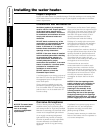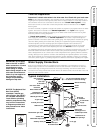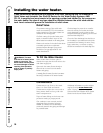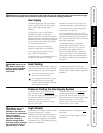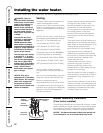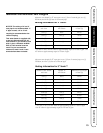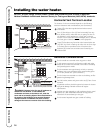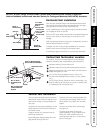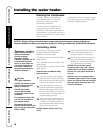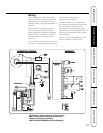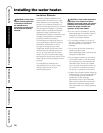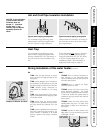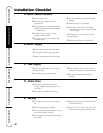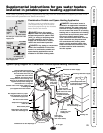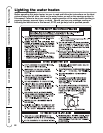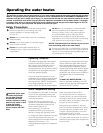
16
Installing the water heater.
All joints in the vent piping must be
properly sealed and the following
materials are recommended:
PVC materials should use ASTM D-2564
grade cement.
CPVC materials should use ASTM F-493
grade cement.
ABS materials should use ASTM D-2235
grade cement.
Cleaner-Primer and Medium Body
Solvent Cement:
Cut pipe end square, remove jagged
edges and burrs. Chamfer end of pipe,
then clean fitting socket and pipe joint
area of all dirt, grease or moisture.
After checking pipe and socket for
proper fit, wipe socket and pipe with
cleaner-primer. Apply a liberal coat of
primer to inside surface of socket and
outside of pipe. Do not allow primer to
dry before applying cement.
Apply a thin coat of cement evenly in
the socket. Quickly apply a heavy coat
of cement to the pipe end and insert
pipe into fitting with a slight twisting
motion until it bottoms out.
NOTICE: Cement must be fluid; if not,
recoat.
Hold the pipe fitting for 30 seconds to
prevent the tapered socket from
pushing the pipe out of the fitting.
Wipe all excess cement from the joint
with a rag. Allow 15 minutes before
handling. Cure time will vary according
to fit, temperature and humidity.
NOTICE: Stir the solvent cement
frequently while using. Use a natural
bristle brush or the dauber supplied
with the can. The proper brush size is
one inch.
NOTICE: This unit is equipped with a
Flammable Vapor Sensor. Do not apply
power until enough time has passed to
allow the vapors from the primer and
cement to dissipate.
Cementing Joints
WARNING: DANGER OF
FIRE OR BODILY INJURY -
Solvent cements and
primers are highly
flammable. Provide
adequate ventilation and do
not assemble near heat
source or open flame. Do
not smoke. Avoid skin or
eye contact. Observe all
cautions and warnings on
material containers.
CAUTION:
For proper installation:
DO NOT use solvent cement
that has become curdled,
lumpy or thickened.
DO NOT thin solvent
cement. Observe shelf
precautions printed on the
containers.
For applications below 32°F
use only low temperature
type solvent cement.
Appropriate solvent and
cleaner must be used for the
type of vent pipe used (PVC,
CPVC or ABS).
Draining the Condensate
In certain conditions, installations in
unconditioned space or having long
horizontal or vertical runs may
accumulate condensate.
In order to prevent condensate from
draining back into the water heater
installing a condensate trap and drain is
recommended in a horizontal vent section
as close as practical to the water heater
vent connection.
Condensate is known to be acidic; refer to
local, state (provincial) or federal codes
for proper handling methods.
NOTICE: All pipe, fittings, solvent cement, primers and procedures must conform to American
National Standards Institute and American Society for Testing and Materials (ANSI/ASTM) standards.
Customer Service Troubleshooting Tips Care and Cleaning Operating Instructions Installation Instructions Safety Instructions



